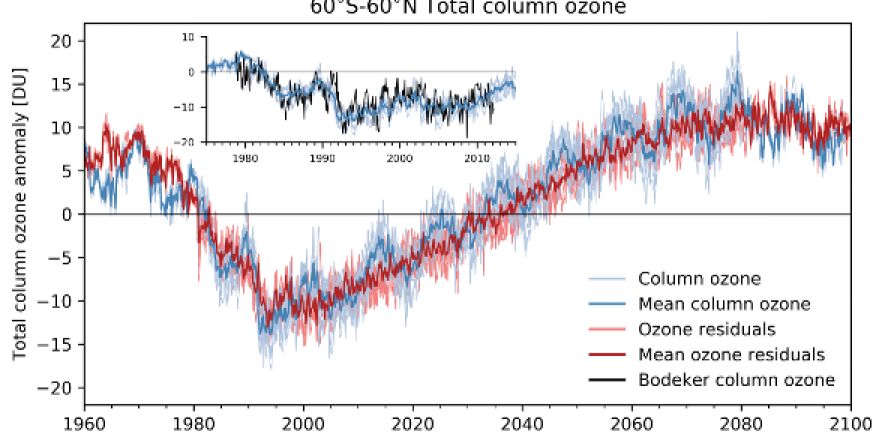
2017 marked the 30th anniversary of the Montreal Protocol, which was implemented to protect the stratospheric ozone layer from the harmful effects of man-made ozone depleting substances.
To get a more complete understanding of global ozone recovery, postdoctoral researchers James Keeble, Luke Abraham and undergraduate student Hannah Brown analysed modelled total column ozone values in the North and South polar regions, the tropics, and the mid-latitudes of the Northern and Southern hemisphere. Total column ozone is the total amount of atmospheric ozone in a given column.
“We aimed to explore the impacts of the Montreal Protocol on total column ozone values, and to answer whether, 30 years after its implementation, we can identify robust recovery of the stratospheric ozone layer resulting from decreased CFC emissions,” said lead author Dr James Keeble. But the researchers, working with Professors John Pyle and Neil Harris (Cranfield University), knew they were facing a difficult task.
One complexity was the large variability of ozone, which is also affected by natural occurrences such as the eruption of Mt Pinatubo in 1991, changes in the solar cycle, and variations in sea surface temperatures - particularly those related to the El Niño Southern Oscillation. Not only that, but the variations themselves are different at different latitudes--for example, ozone levels in high northern latitudes vary significantly between winter and spring, but they are more stable in the southern hemisphere.
To account for these variabilities, the researchers used coupled chemistry-climate model (CCM) simulations to analyse ozone levels and predict ozone trends. Each simulation constitutes a possible future evolution of stratospheric ozone, taking into account different variabilities, and allowing greater confidence in the mean trend, as the number of variabilities is included. "It is important to note that we did not use measurements in the study, except to validate the model by comparing it with observations in the time period for which observations were available," said James.
Because of the large natural variability of ozone levels, the team did not use dates of minimum ozone as a gauge of ozone recovery. Instead, they defined ozone recovery in three ways: first, as a slowed rate of ozone decline, second, as a positive trend upward and third, by comparing current ozone levels to historic values.
Using the CCM simulations to analyse trends of total ozone from 2000-2017 and accounting for natural cycles, the group found that ozone was increasing at most latitudes, and that these increases were statistically significant in the mid-latitudes in both hemispheres. Based on these models, they projected that significant positive trends could be identified in the tropics and at the highest latitudes within the near future.
The researchers concluded that by 2030, we will be seeing significant positive trends in total column ozone in all latitudes, although ozone values lower than the 1980 annual mean could still occur in the mid-latitudes until about 2050, and in the tropics and high latitudes deep into the second half of the 21st century.
“Statistically significant increases in total column ozone are a real sign that ozone recovery is occurring, but recovery can only be said to be complete when total column ozone values reach their pre-CFC values,” said James. These values are traditionally taken from 1960 or 1980. “Earliest recovery would be considered the first time ozone reaches those levels, and final recovery is the last time ozone falls below these values,” he said.
The exact timing of when recovery can be said to have occurred varies with latitude. For example, using the 1980 cut-off, the team estimated earliest recovery at high southern latitudes to occur by about 2040, with final recovery occurring by 2060.
Head of Department Professor John Pyle, who was recently awarded the Royal Society's Davy Medal for his "pioneering leadership in understanding the depletion of the global ozone layer" said: “These trends send a positive signal that nations and industries can work together to repair damage to the environment, and to protect it for future generations."
The paper is featured as a ‘highlight paper’ in the open-access European Geosciences Union journal Atmospheric Chemistry and Physics, published 1 June 2018.
On ozone trend detection: using coupled chemistry–climate simulations to investigate early signs of total column ozone recovery research, Atmos. Chem. Phys., 18, 7625-7637, 2018, James Keeble, Hannah Brown, N. Luke Abraham, Neil R.P. Harris, and John A. Pyle.

